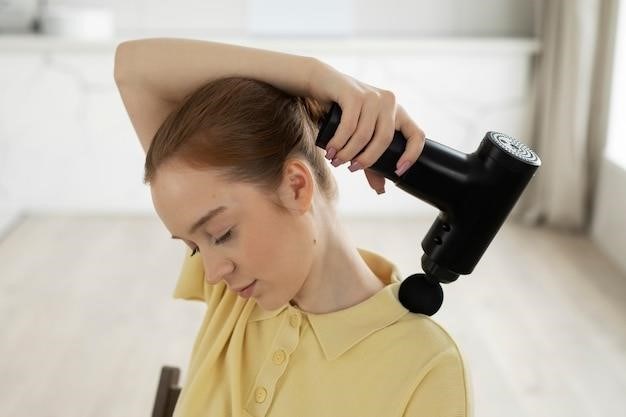Massage Gun User Manual PDF⁚ A Comprehensive Guide
This comprehensive guide delves into the world of massage guns, covering their uses, benefits, and essential information for safe and effective use. From understanding the basics to navigating user manuals and troubleshooting common issues, this guide serves as your one-stop resource for maximizing your massage gun experience.
Introduction
Welcome to the world of massage guns! These powerful handheld devices have revolutionized the way we approach muscle recovery, pain relief, and overall wellness. Massage guns utilize percussive therapy, delivering rapid, targeted pulses to muscles, promoting relaxation, reducing soreness, and improving flexibility. This guide will serve as your comprehensive resource for understanding massage guns, their benefits, and how to use them effectively and safely. From navigating user manuals to mastering different massage techniques, we’ll cover everything you need to know to make the most of your massage gun experience. Prepare to unlock a new level of muscle care and experience the transformative power of percussive therapy.
What is a Massage Gun?
A massage gun, also known as a percussion massager, is a handheld device designed to deliver targeted deep tissue massage through rapid, rhythmic pulses. It operates by using a powerful motor to drive a massage head that vibrates at high speeds, mimicking the feeling of a professional massage therapist’s hands. The intensity and frequency of these vibrations can be adjusted, allowing users to customize the massage experience to their specific needs and preferences. These versatile devices are becoming increasingly popular among athletes, fitness enthusiasts, and anyone seeking relief from muscle soreness, stiffness, and tension. Massage guns offer a convenient and effective way to promote muscle recovery, improve blood circulation, and enhance overall well-being.
Benefits of Using a Massage Gun
Massage guns offer a range of benefits that can enhance both physical performance and overall well-being. One of the primary advantages is their ability to reduce muscle soreness and stiffness, particularly after intense workouts or strenuous activity. The deep tissue massage provided by a massage gun helps to break down lactic acid buildup, which is a common cause of post-workout muscle pain. This can significantly speed up recovery time, allowing individuals to return to their training routines more quickly. Moreover, massage guns can improve flexibility and range of motion by loosening tight muscles and fascia, which is the connective tissue that surrounds muscles. This improved flexibility can enhance athletic performance and reduce the risk of injuries. Beyond physical benefits, massage guns can also promote relaxation and stress relief. The rhythmic vibrations can help to calm the nervous system and reduce tension, providing a sense of well-being.
Choosing the Right Massage Gun
Choosing the right massage gun involves considering several factors that align with your individual needs and preferences. One crucial aspect is the amplitude, which refers to the depth of the massage. Higher amplitude guns are suitable for targeting deep muscle knots and fascia, while lower amplitude guns are better for lighter massages. The speed or percussions per minute (PPM) is another key consideration; Higher PPM settings provide a more intense massage, ideal for athletes or those with chronic muscle tension. However, lower PPM settings may be more comfortable for beginners or those with sensitive areas. Battery life is essential, especially for those who travel or use the massage gun frequently. Look for models with long battery life and fast charging capabilities. The weight and ergonomics of the massage gun are important for comfort and ease of use. Opt for a model that feels comfortable to hold and maneuver, especially if you plan to use it for extended periods. Finally, the availability of different massage heads can expand the versatility of the massage gun. Choosing a model with multiple heads allows you to target specific muscle groups and achieve different massage techniques.
Massage Gun User Manual⁚ Essential Information
The massage gun user manual serves as a crucial guide for understanding and utilizing your device safely and effectively. It typically includes detailed instructions on various aspects, such as safety precautions, charging and battery life, operating instructions, massage head types and uses, and maintenance and cleaning. Safety precautions emphasize the importance of avoiding direct contact with bones, joints, and sensitive areas. Proper charging procedures and estimated battery life are crucial for uninterrupted use. Operating instructions outline the different speed settings and how to adjust them based on individual preferences and muscle needs. Understanding the various massage head types and their corresponding uses allows for targeted and personalized massage experiences. Finally, regular maintenance and cleaning instructions ensure the longevity and hygiene of your massage gun.
5.1. Safety Precautions
Safety precautions are paramount when using a massage gun, as improper usage can lead to injuries or discomfort. User manuals typically highlight the importance of avoiding direct contact with bones, joints, and sensitive areas like the spine, ankles, and elbows. They emphasize the need to use the device on clothed areas, lightly pressing and moving across the body for approximately 60 seconds per region. Additionally, they advise against using the massage gun on injured areas or if experiencing any pain or discomfort. It’s crucial to consult a healthcare professional before using a massage gun if you have any underlying health conditions or concerns. Following these safety guidelines ensures a safe and enjoyable massage experience.
5.2. Charging and Battery Life
Massage gun user manuals typically provide detailed instructions on charging and battery life. They usually specify the type of charger required (often a USB-C cable) and the charging time, which can vary depending on the model. The manual may also include information on battery capacity and estimated run time on a full charge. It’s important to note that battery life can be affected by factors such as usage intensity and ambient temperature. User manuals often recommend charging the battery fully before first use and avoiding overcharging, as this can shorten its lifespan. They may also provide tips on extending battery life, such as using the device at lower speeds and avoiding extreme temperatures. Understanding these guidelines ensures optimal battery performance and extends the longevity of your massage gun.
5.3. Operating Instructions
Massage gun user manuals provide clear and concise instructions on how to operate the device safely and effectively. They typically begin by explaining how to turn the device on and off, often using a power button located on the body of the gun. The manual will then guide you through selecting the appropriate speed setting, which is usually controlled by buttons or a dial. Many massage guns offer multiple speed levels, ranging from low-intensity for sensitive areas to high-intensity for deep tissue work. The manual will also explain how to attach and detach the different massage heads, which are designed for targeting specific muscle groups and providing different types of massage. It may include a diagram or visual representation to illustrate the process. The manual often emphasizes the importance of applying gentle pressure and avoiding bony areas or joints. Finally, it may provide tips on proper posture and movement techniques to ensure a safe and comfortable massage experience.
5.4. Massage Head Types and Uses
A key feature of massage guns is their versatility, achieved through interchangeable massage heads. User manuals typically provide a detailed description of each head type and its specific application. The most common types include a round head for general muscle work, a bullet head for targeting trigger points, a flat head for larger muscle areas, a U-shaped head for the spine and neck, and a fork head for surrounding muscles. The manual will explain the benefits of each head, such as increased blood flow, muscle relaxation, and pain relief. It may also offer guidance on which head to use for different body parts and muscle groups. For example, the bullet head is often recommended for tight spots or knots, while the flat head is ideal for larger muscle groups like the back or legs. Understanding the nuances of each head type allows users to tailor their massage experience for optimal results and personalized relief.
5.5. Maintenance and Cleaning
Proper maintenance is crucial for extending the lifespan of your massage gun. User manuals typically outline specific instructions for cleaning and storage, ensuring optimal performance. They usually recommend wiping down the device and its attachments with a damp cloth after each use. This helps remove any sweat, oil, or debris that may accumulate during massage sessions. Some manuals might also suggest using a mild cleaning solution, but it’s important to avoid harsh chemicals that could damage the device. The manual may also provide instructions for storing the massage gun and its attachments in a clean and dry place when not in use. This helps prevent dust accumulation and potential damage. Following these recommendations ensures your massage gun remains in top condition and continues to provide effective and enjoyable massage experiences for years to come.

Using a Massage Gun for Different Body Parts
Massage guns are designed for targeted deep tissue massage, but their application varies depending on the body part. User manuals often provide guidance on using the massage gun for specific areas. For example, they might recommend using a round head attachment for large muscle groups like the back, legs, and glutes, while a bullet head is more suitable for smaller areas like the neck, shoulders, and calves. The manual might also suggest using a lower intensity setting for sensitive areas like the neck and shoulders and increasing the intensity for larger muscle groups. They may also provide specific instructions for using the massage gun on different body parts, such as holding the device at a certain angle or applying pressure in a particular direction. By following these recommendations, you can ensure that you’re using the massage gun safely and effectively for all your targeted muscle groups.
Common Massage Gun Mistakes to Avoid
While massage guns can be incredibly beneficial, there are common mistakes that users often make. These mistakes can range from using the wrong massage head to applying too much pressure or neglecting proper maintenance. User manuals often highlight these common errors and provide guidance on how to avoid them. For example, they might advise against using the massage gun directly on bones or joints, as this can cause discomfort or injury. They might also recommend avoiding using the massage gun on sensitive areas like the face or neck, as this can lead to discomfort or irritation. Additionally, user manuals typically emphasize the importance of regular cleaning and maintenance to ensure the longevity and effectiveness of the massage gun. By following these guidelines, you can minimize the risk of making common mistakes and maximize the benefits of your massage gun.
Where to Download Massage Gun User Manuals
Finding the right massage gun user manual is essential for understanding its features, safety guidelines, and proper use. Fortunately, there are several convenient ways to access these manuals. Many manufacturers provide downloadable PDF versions of their user manuals on their official websites. These manuals often include detailed instructions, diagrams, and troubleshooting tips. Additionally, online retailers like Amazon often host user manuals for the products they sell. If you’ve purchased your massage gun from a specific retailer, they may also provide access to the user manual on their website or through customer support. For those who prefer physical copies, some manufacturers offer printed user manuals with their products. However, accessing user manuals online is often the most convenient and readily available option.


